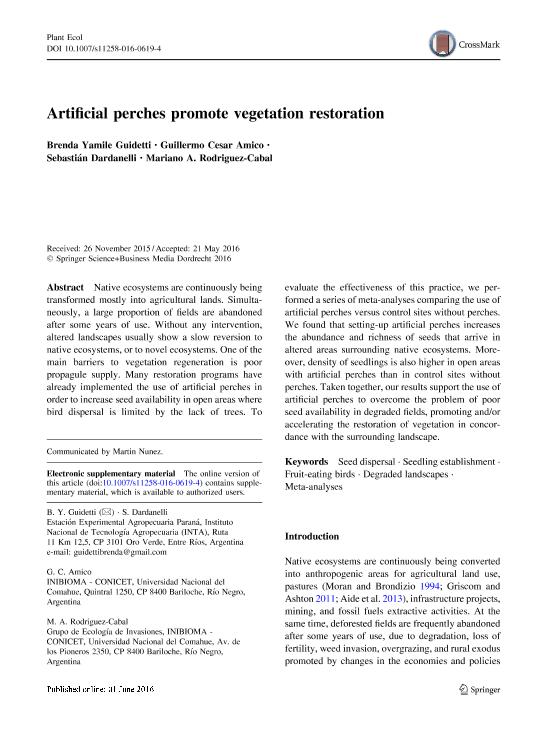Mostrar el registro sencillo del ítem
dc.contributor.author
Guidetti, Brenda Yamile

dc.contributor.author
Amico, Guillermo Cesar

dc.contributor.author
Dardanelli, Sebastián

dc.contributor.author
Rodriguez Cabal, Mariano Alberto

dc.date.available
2019-03-07T19:59:20Z
dc.date.issued
2016-07
dc.identifier.citation
Guidetti, Brenda Yamile; Amico, Guillermo Cesar; Dardanelli, Sebastián; Rodriguez Cabal, Mariano Alberto; Artificial perches promote vegetation restoration; Springer; Plant Ecology; 217; 7; 7-2016; 935-942
dc.identifier.issn
1385-0237
dc.identifier.uri
http://hdl.handle.net/11336/71202
dc.description.abstract
Native ecosystems are continuously being transformed mostly into agricultural lands. Simultaneously, a large proportion of fields are abandoned after some years of use. Without any intervention, altered landscapes usually show a slow reversion to native ecosystems, or to novel ecosystems. One of the main barriers to vegetation regeneration is poor propagule supply. Many restoration programs have already implemented the use of artificial perches in order to increase seed availability in open areas where bird dispersal is limited by the lack of trees. To evaluate the effectiveness of this practice, we performed a series of meta-analyses comparing the use of artificial perches versus control sites without perches. We found that setting-up artificial perches increases the abundance and richness of seeds that arrive in altered areas surrounding native ecosystems. Moreover, density of seedlings is also higher in open areas with artificial perches than in control sites without perches. Taken together, our results support the use of artificial perches to overcome the problem of poor seed availability in degraded fields, promoting and/or accelerating the restoration of vegetation in concordance with the surrounding landscape.
dc.format
application/pdf
dc.language.iso
eng
dc.publisher
Springer

dc.rights
info:eu-repo/semantics/openAccess
dc.rights.uri
https://creativecommons.org/licenses/by-nc-sa/2.5/ar/
dc.subject
Degraded Landscapes
dc.subject
Fruit-Eating Birds
dc.subject
Meta-Analyses
dc.subject
Seed Dispersal
dc.subject
Seedling Establishment
dc.subject.classification
Otras Ciencias Biológicas

dc.subject.classification
Ciencias Biológicas

dc.subject.classification
CIENCIAS NATURALES Y EXACTAS

dc.title
Artificial perches promote vegetation restoration
dc.type
info:eu-repo/semantics/article
dc.type
info:ar-repo/semantics/artículo
dc.type
info:eu-repo/semantics/publishedVersion
dc.date.updated
2019-02-12T16:55:28Z
dc.journal.volume
217
dc.journal.number
7
dc.journal.pagination
935-942
dc.journal.pais
Alemania

dc.journal.ciudad
Berlin
dc.description.fil
Fil: Guidetti, Brenda Yamile. Consejo Nacional de Investigaciones Científicas y Técnicas; Argentina. Instituto Nacional de Tecnología Agropecuaria. Centro Regional Entre Ríos. Estación Experimental Agropecuaria Paraná; Argentina
dc.description.fil
Fil: Amico, Guillermo Cesar. Consejo Nacional de Investigaciones Científicas y Técnicas. Centro Científico Tecnológico Conicet - Patagonia Norte. Instituto de Investigaciones en Biodiversidad y Medioambiente. Universidad Nacional del Comahue. Centro Regional Universidad Bariloche. Instituto de Investigaciones en Biodiversidad y Medioambiente; Argentina
dc.description.fil
Fil: Dardanelli, Sebastián. Consejo Nacional de Investigaciones Científicas y Técnicas; Argentina. Instituto Nacional de Tecnología Agropecuaria. Centro Regional Entre Ríos. Estación Experimental Agropecuaria Paraná; Argentina
dc.description.fil
Fil: Rodriguez Cabal, Mariano Alberto. Consejo Nacional de Investigaciones Científicas y Técnicas. Centro Científico Tecnológico Conicet - Patagonia Norte. Instituto de Investigaciones en Biodiversidad y Medioambiente. Universidad Nacional del Comahue. Centro Regional Universidad Bariloche. Instituto de Investigaciones en Biodiversidad y Medioambiente; Argentina
dc.journal.title
Plant Ecology

dc.relation.alternativeid
info:eu-repo/semantics/altIdentifier/doi/https://dx.doi.org/10.1007/s11258-016-0619-4
dc.relation.alternativeid
info:eu-repo/semantics/altIdentifier/url/https://link.springer.com/article/10.1007/s11258-016-0619-4
Archivos asociados
